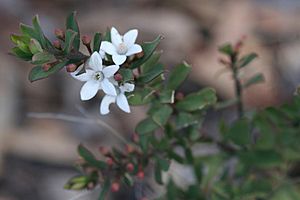Philotheca epilosa facts for kids
Quick facts for kids Philotheca epilosa |
|
|---|---|
 |
|
| In Girraween National Park | |
| Scientific classification | |
| Genus: |
Philotheca
|
| Species: |
epilosa
|
The Philotheca epilosa is a special kind of flowering plant that belongs to the family called Rutaceae. This plant is only found in eastern Australia, which means it is endemic to that area.
It's a shrub with leaves that look like an egg or a spear, with the narrower part closer to the stem. These leaves are often grouped together near the ends of its branches, which have small, bumpy glands. The plant usually has white flowers that grow by themselves at the tips of the branches.
What it Looks Like
Philotheca epilosa is a shrub that can grow up to about 1 m (3 ft 3 in) tall. Its branches have small, bumpy glands on them. The leaves are usually found in clusters near the ends of the branches. They are also bumpy and shaped like an egg or a spear, with a pointy tip. These leaves are about 4–30 mm (0.16–1.18 in) long and 2–10 mm (0.079–0.394 in) wide.
The flowers usually grow one by one at the very end of the branches. Each flower sits on a short stalk, about 1–3 mm (0.039–0.118 in) long, with an even shorter stem, about 2–5 mm (0.079–0.197 in) long. The flowers have round sepals, which are small leaf-like parts, about 1 mm (0.039 in) long. They also have five white petals that are about 5–8 mm (0.20–0.31 in) long and 2–3.5 mm (0.079–0.138 in) wide. Inside the flower, there are ten hairy stamens, which are the parts that make pollen.
This plant blooms, or flowers, from August to September. After flowering, it produces a fruit that is about 5–7 mm (0.20–0.28 in) long and has a clear beak-like shape.
How it Got its Name
This plant was first officially described in 1970 by a scientist named Paul G. Wilson. He first called it Eriostemon myoporoides subsp. epilosus. He wrote about it in a science journal called Nuytsia. The plants he studied were collected way back in 1906 near a place called Wallangarra.
Later, in 2005, another scientist named Paul Irwin Forster decided that this plant was special enough to be its own species. So, he gave it the name Philotheca epilosa. He published this new name in a journal called Austrobaileya.
Where it Grows
You can find Philotheca epilosa growing in open areas called heathlands and in forests. It often grows among large granite rocks. It is found in northern New South Wales, in places like Deepwater and Torrington. It also grows in south-eastern Queensland, near a town called Stanthorpe.

